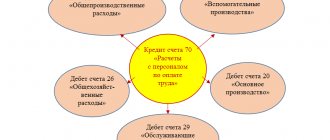Principles of calculating vacation pay
Each employee is now entitled to at least 28 days of rest per year (Article 115 of the Labor Code of the Russian Federation). Certain categories of workers are entitled to additional vacation days (for example, for irregular work hours, work in difficult, complex, dangerous conditions, etc.). They may be used at the discretion of the staff at any convenient time.
Annual paid leave is paid at the expense of the employer. To determine the amount of vacation pay due, you can use a simple formula:
Calculation formula
Amount otp = Sdvz (average daily earnings) * Kdo (number of rest days).
The same formula is used by accountants if an employee takes a vacation in advance and quits. It is used to determine the vacation pay due to him for the actual time worked, and deduct this amount from previously paid vacation pay. The resulting difference constitutes the employee's debt to the company.
The main difficulty for an accountant when calculating vacation pay is the correct determination of average daily earnings. It depends on:
- billing period;
- accrual amounts;
- number of days worked in the selected period.
The rules for calculating average earnings are given in Resolution No. 922 of December 24, 2007 (as amended). We list the main postulates that an accountant should know:
- If an employee has been working for a company for more than a year, his income for the 12 months preceding the vacation is taken into account. Otherwise, it is necessary to use for calculations earnings for the months worked preceding the month in which the employee goes on vacation. It is prohibited to arbitrarily change the billing period.
- The calculation includes only payments related to the payroll, i.e. accruals for actually worked hours, all kinds of bonuses, payments for achieving high results, overtime work, etc. Business trips, social benefits, vacation pay, one-time bonuses for anniversaries and other payments not related to payroll are excluded from the total income, since they themselves are determined by calculation.
- If staff salaries were raised during the billing period, earnings for previous months are indexed by the calculated coefficient.
The same rules apply if it is necessary to determine the amount of compensation for unused vacation upon dismissal or to recalculate vacation pay. The above formula is also used here.
How to calculate the amount of overpaid vacation pay upon dismissal
Calculation of withholding for leave upon dismissal is made using the following formula:
UDNO = (FEFD − DOS) × WHSD,
Where:
UDNO - deduction for days of unused vacation;
DFO - the number of vacation days actually taken;
DOS - the number of vacation days allotted in accordance with the vacation record;
ZSD - average daily earnings calculated at the time of payment of vacation pay.
Stages of calculating intermediate indicators:
- To calculate the DOS indicator, you must divide by 12 the number of vacation days stipulated by law or employment contract for the working year (minimum 28 days). Then the resulting value should be multiplied by the number of months actually worked. If the resulting number of days turns out to be a fractional number, then it is rounded in favor of the employee (letter of the Ministry of Health and Social Development “On the procedure for determining the number of vacation days...” dated December 7, 2005 No. 4334-17).
- WHSD is calculated in the manner specified in Part 4 of Art. 139 of the code, taking into account the adjustment for the time actually worked, if it does not reach 12 months (clause 6 of the regulation, approved by the government decree “On the specifics of the procedure for calculating average wages” dated December 24, 2007 No. 922).
So, deduction for vacation used in advance but not worked is made in the amount of no more than 20% of the earnings paid upon dismissal. The amount of debt that exceeds the amount of actual withholding is repaid by the dismissed individual or collected by the employer through the court. It is important to remember that in some cases there is a ban on making deductions upon dismissal (for example, due to the liquidation of the employer).
How to determine average daily earnings
To calculate the vacation debt, the accountant must determine the average daily earnings (Article 139 of the Labor Code of the Russian Federation). But there is no need to separately calculate this indicator as of the date of dismissal. Use in the calculation the amount that was on the start date of the employee’s vacation. This procedure is due to the fact that the company retains the money that the employee received previously.
How to calculate the number of unworked months
In addition to average earnings, the accountant determines how many months the employee did not work in a year, during which he already had time to take vacation. When calculating, use two rules.
This is also important to know:
Dismissal due to liquidation of an enterprise: payments, procedure, sample notice
The first rule is that the accounting year is not equal to the calendar year, that is, it does not have to start on January 1 and end on December 31.
An employee has the right to annual paid leave every year (Article 122 of the Labor Code of the Russian Federation). It is equal to 12 months and starts from the date of hiring (letter of Rostrud dated June 14, 2012 No. 853-6-1). Moreover, the length of service for calculating vacation includes (Article 121 of the Labor Code of the Russian Federation):
- days the employee worked;
- annual leave, days of incapacity, holidays and weekends;
- days that the employee took at his own expense. But no more than 14 calendar days per year are taken into account.
The second rule is that if an employee, in addition to whole months, also has unworked days, then they are rounded up to full months. The main thing to remember here is that a balance of 14 days or less is not taken into account. And days starting from 15 are rounded up to a full month.
For example, an employee has 4 months and 17 days left unworked. Then the accountant will take into account the deduction of 5 months.
How to find out how many vacation days an employee is entitled to per year
Typically, vacation is 28 calendar days (Part 1, Article 115 of the Labor Code of the Russian Federation). For most employees, this is the value that the accountant will take to calculate compensation and deductions for unused vacation upon dismissal. However, there are exceptions.
For example, if your employee is under 18 years old, then he should have 31 calendar days of vacation (Article 267 of the Labor Code of the Russian Federation). For teachers, the formula uses 42 or 56 days (Article 334 of the Labor Code of the Russian Federation). The specific value depends on the position of the teacher (Resolution of the Government of the Russian Federation of May 14, 2015 No. 466). Disabled people have the right to 30 days (Article 23 of the Federal Law of November 24, 1995 No. 181-FZ).
How much can be withheld from an employee for vacation used in advance upon dismissal?
Of the payments due to an employee upon dismissal, the accountant has the right to withhold no more than 20 percent of the amount that remains after deducting personal income tax (Article 138 of the Labor Code of the Russian Federation). Anything above that, the employee has the right to pay off voluntarily.
Example
The manager started working on August 22, 2021. He retires on June 19, 2021. In December 2021, the manager took 28 calendar days off. The average daily earnings was 501 rubles.
The manager's working year begins on August 22, 2021 and ends on August 21, 2021. The unworked period is two months and two days. According to the rules, we round this value to two full months.
For June 2021, the manager was credited 25,000 rubles. He has no deductions for personal income tax, so the tax is 3,250 rubles. (RUB 25,000 x 13%). Amount to be issued – 21,750 rubles. (25,000 rub. - 3,250 rub.)
You can withhold no more than 4,350 rubles. (RUB 21,750 × 20%).
The debt for vacation provided in advance is 2,338 rubles. (501 rubles × 2 months × 28 days: 12 months). The accountant can withhold the entire amount of the debt from the salary.
Example 1. Calculation of the withheld amount of excess payment for vacation pay upon dismissal
A.V. Ostrov worked at Vasilek LLC from December 1, 2015. His working year was supposed to last until November 20, 2021. During this period, he was granted leave of 28 days. The average employee's earnings were 230 rubles. But A.V. Ostrov resigned on June 30, 2016. The amount to be withheld is calculated.
| Data for calculation | Calculations |
| Number of vacation days - 28; number of months in a year - 12; number of unworked months of the dismissed person - 5 | Unworked vacation time (by days): 28 / 12 (months) = 2.3 days; 2.3 (days) * 5 (number of months not worked) = 11 days (rounded) |
| The unworked part of the vacation is 11 days; average earnings are 230 rubles. | Retention amount: 11 days * 230 rub. = 2,530 rub. |
It turns out that the fired person did not work for 5 months. This means that he was paid an extra amount of vacation pay, which should be returned to the cash desk of Vasilek LLC. So, Vasilek LLC withheld 2,530 rubles. from the amount of salary paid to the dismissed A.V. Ostrov when calculated on the last day of work.
Example 2. Withholding of excess vacation pay upon dismissal of an employee, standard account assignments
P. V. Smirnov worked at Zorka LLC from January 15, 2016. He was granted leave from July 15, 2016 for a period of 12 days. After his vacation, P.V. Smirnov worked until August and resigned by agreement of the parties on August 15, 2016. Thus, he did not work until the end of the working year for 5 months.
Since the dismissed person took 12 days of vacation for a full working year, and did not work for 5 months, the employer has the right to return the excess payment of money for 5 days (12 / 12 = 1 day; 1 * 5 = 5 days). On the last day of work, P.V. Smirnov was given the payments due, from which the amount for the 5 unworked days of vacation pay was withheld. The accounting department used the following basic account assignments:
- DT 20 (26, 44, etc.), CT 70 - crediting salary upon dismissal;
- DT 20 (26, 44, etc.), CT 69 - contributions to the Pension Fund;
- DT 70, CT 68 - personal income tax calculation;
- DT 20 (26, 44, etc.), CT 70 - reduction of expenses by the amount of excess vacation pay payments;
- DT 20 (26, 44, etc.), CT 69 - correction of PFR;
- DT 70, CT 68 - personal income tax correction;
- DT 70, CT 50 - salary issued.
When an employee takes rest in advance
There are quite a lot of situations in which an employee needs leave that he has not yet earned. Let's list the main ones:
- the vacation schedule is designed in such a way that some employees take them in advance;
- due to personal circumstances, the specialist is forced to go on vacation earlier than planned;
- the employee decides to quit without working for a full year;
- The company is experiencing staff reductions, and some of the staff are being laid off without being given the opportunity to take their required vacation.
In all these cases, the accountant needs to figure out how much vacation pay is due to dismissed employees, and, if necessary, make a deduction for unworked vacation days upon dismissal. Let's figure out how to do this without neglecting the norms of labor legislation.
How to issue an order for a voluntary refund of funds for a vacation in advance?
Answer to the question: Labor legislation does not regulate the procedure for registering an employee’s voluntary return of funds for unworked vacation days.
Thus, by the time of dismissal Ptichkin P.
According to the general rule established by Article 137 of the Labor Code of the Russian Federation, the employer has the right to deduct from the employee’s salary when dismissing the employee before the end of the working year for which he has already received annual paid leave for unworked vacation days. In this case, the amount of withholding cannot exceed 20% for each salary payment.
If, upon dismissal, the payment amount is not enough to repay unearned vacation pay, the employee can return the funds voluntarily. Read about so as not to make mistakes.
To do this, he should write a statement indicating that the employee, on his own initiative, returns to the employer part of the vacation pay (for unworked vacation days) in the amount of ______. Sample application. I ask you to accept funds in the amount of __________ rubles received by me for unworked vacation days.
I return the money on my own initiative.
Signature Date We note that upon dismissal of an employee, a settlement note is drawn up in form T-61. This document reflects information about used and unused vacation days and calculates payments.
The calculation note does not reflect information about the amounts refunded by the employee for unworked vacation. Therefore, it cannot be a document confirming the employee’s return of funds. You will find important information about it in the material here.
Please note that cash is accepted by a legal entity, including from an employee, using cash receipt orders 0310001 (clause 5 of Bank of Russia Directive No. 3210-U dated March 11, 2014). An order from the employer is not needed in this situation, since in this case we are talking about the actions of the employee, and not about the order of the employer.
Meanwhile, if the organization’s accounting policy establishes the need to issue an order to accept funds, the employer should
Overpaid vacation pay: to keep or not
There is no provision in the law forcing the employer to recover from the employee the amount of overpaid vacation pay. Collecting a debt is the right, not the obligation of the employer.
When resolving this issue, it is recommended to proceed from whose initiative the employment contract is terminated. If the employee breaks the contract, he is obliged to repay the debt. If the employer terminates the employment relationship, he usually forgives the debt.
Free legal consultation
Free legal consultation We will answer your question in 5 minutes!
Ask a Question
We will answer your question in 5 minutes!
Ask a Question
This is also important to know:
Can a pregnant woman be fired from her job?
If the company decides to forgive an employee's debt, this should be documented. When dismissing an employee, it is recommended to conclude a bilateral agreement with him, which indicates the amount of vacation pay owed and the number of days of rest taken in advance.
A clause stating the absence of financial claims is often included in the document in order to exclude the very possibility of their occurrence. The rest of the agreement is drawn up according to the rules of business transactions.
In practice, most companies force staff to reimburse overpaid vacation pay, since no one wants to bear additional expenses. Consequently, if an employee took a vacation in advance and quits, the accountant will have to calculate the amount of “extra” vacation pay. An analysis of the following situation will help you understand the mechanism for calculating debt.
Example 2
Nikodimov A.D. got a job as a foreman on 02/01/2019. By agreement with management, he took the first part of his vacation from June 1 to June 14, 2021, and the second from September 1 to September 14, 2021. While still on vacation, Nikodimov decided to quit. Based on the statement, his last day of work in the organization was September 15, 2019.
In fact, the employee worked for the company for only 7 months. During this period, he is entitled to 16.31 days of rest (2.33 * 7). However, the employee used his entire vacation. Since the company did not want to forgive his vacation pay debt, the accountant needs to withhold vacation pay upon dismissal, used by Nikodimov A.D. in advance.
11.69 vacation days (28 – 16.31) are subject to compensation. Let's assume that the average daily earnings, calculated in accordance with Resolution No. 922, amounted to 965.80 rubles. Therefore, 11,290.20 rubles must be withheld from the employee. (11.69 * 965.80). As can be seen from the example, the employee’s debt to the company turned out to be quite significant.
Can payment for unworked vacation days be withheld upon dismissal?
Based on Article 122 of the Labor Code of the Russian Federation, in the first year of work in an organization, an employee has the right to leave after six months of continuous work. In subsequent years, vacation time can be distributed according to the vacation schedule at the given enterprise.
Thus, after working for six months, a worker has the right to go on full paid leave for 28 calendar days, despite the fact that he earned only 14 days during this period. The remaining two weeks are provided to the employee in advance, which he must work in the next six months.
If an employee decides to quit before the end of the working year, taking vacation in advance, then the manager has the right to withhold overpaid vacation pay from him in the settlement.
This is a justified and legal action, since the payment given in advance to an employee for vacation will not be worked out until the end of the working year upon termination of the employment contract.
At the same time, referring to Article 138 of the Labor Code of the Russian Federation, the amount of withholding from vacation payments cannot exceed 20 percent.
Important! Withholding for unworked vacation periods taken in advance is considered the right of the employer, but not his obligation.
If the entrepreneur has decided to return the unearned amount of vacation pay, then the consent of the employee who took the vacation in advance is not required.
But if the latter does not have the required amount to pay, or it exceeds the percentage prescribed by law, he has the right to pay it voluntarily.
There are also certain situations when the deduction of overpaid vacation pay is impossible for reasons provided for by the Labor Code.
Rules and methods for calculating vacation pay.
You can calculate your vacation pay using the online calculator here.
Simple, convenient and free calculator.
When can you not return overpaid vacation pay?
Article 137 of the Labor Code of the Russian Federation specifies the conditions under which the amount given in advance upon dismissal cannot be withheld before the end of the working year.
Thus, an employee does not need to return the used advance payment for vacation time off if he was fired due to the following circumstances:
- refusal to transfer to another job due to a medical report;
- liquidation of an enterprise or termination of the activities of its director;
- reduction of staff;
- change of owner of the organization;
- conscription of a mercenary for military service;
- reinstatement of the previous employee;
- declaring an employee incapable of work based on a medical certificate;
- death of a manager or subordinate;
- the occurrence of emergency circumstances in which continuation of work is impossible (war, natural disaster, catastrophe, major accident, etc.).
If the above circumstances are not discovered upon dismissal, the employer’s withholding of vacation pay paid in advance will be legal.
Refunds of overpaid funds are made voluntarily by the employee or through legal proceedings in the event of the latter’s refusal.
How are vacation pay retained?
Usually, upon final payment, the employee is owed money for several days worked but not yet paid. From this amount, in fact, deductions are made for unused vacation upon dismissal. The employee is simply paid the difference between the last month’s salary and previously accrued vacation pay. The accountant does not need additional instructions for such an operation, just as there is no need to obtain the employee’s consent to adjust the payments due.
Sometimes wages are not enough to pay off the debt (in the example above, the employee was owed only 1 day's wages) or there is none at all. Then the resigning employee must repay the debt on his own. This is usually done by depositing cash into the company's cash desk.
The accountant who recalculated vacation pay issues a credit order to the employee upon his dismissal. Based on this document, the employee deposits the excess amount paid to him into the cash register. If the debt is repaid in full, the quitter receives his work book and says goodbye to the employer.
Sometimes an employee refuses to reimburse overruns, citing lack of funds. The employer can meet him halfway by increasing the debt payment period to 1 month. If after this time the debt remains unpaid, the employer has the right to go to court to recover funds.
Accounting entries
It is important to properly reflect the withholding of vacation pay upon dismissal on the balance sheet. To do this, an entry is made in the accounts of salaries and expenses for them. The previously made entry to reflect vacation pay is reversed, and instead, a posting is generated for the amount of compensation upon dismissal. For example,
This is also important to know:
Dismissal from the company by transfer: what the employee and the employer need to know about
Dt 20 – Kt 70 in the amount of RUB 15,000.00. (reversal of vacation pay previously reflected in the balance sheet).
Dt 20 – Kt 70 in the amount of 10,000.00 (correctly calculated amount of compensation).
A credit balance of 70 means that the withholding for vacation upon dismissal resulted in the employee's debt to the company. As stated above, this debt is usually refundable. Repayment can be reflected by posting:
Dt 50 – Kt 70 (the employee paid the company in cash).
It is possible to transfer the debt non-cash to the company's current account, but laid-off workers rarely take advantage of this option.
The debit balance on account 70 shows that the deduction upon dismissal for the leave provided in advance did not result in the employee’s debt. In other words, the payments due to him were enough to compensate for the overpayment of vacation pay. In this case, the remaining money is given to the dismissed person in cash or transferred to his plastic card:
Dt 70 – Kt 50 (51).
Under what circumstances does the right to withhold for vacation upon dismissal arise?
Six months after the start of work with a specific employer (and sometimes earlier - by agreement of the parties or on the basis of Part 3 of Article 122 of the Labor Code of the Russian Federation), the employee receives the right to his first annual leave. According to Art. 115 of the code, the duration of paid leave cannot be less than 28 days.
Leave provided in advance upon dismissal before working for 12 months gives the employer the right to withholding for leave upon dismissal. After all, vacation pay is calculated for the entire period, i.e., for 28 days, which are due to the employee once a year, but in this case the year was never worked out, although the vacation has already been used.
Prohibition on withholding vacation pay
Sometimes an accountant is tormented by the question of how to retain overpaid vacation pay upon dismissal, but it turns out that this is not necessary. Article 137 of the Labor Code of the Russian Federation lists situations in the event of which it is prohibited to deprive an employee of money previously paid to him. Here are the reasons for dismissal:
- voluntary or forced liquidation of the company;
- termination of contracts with senior management due to a change in ownership;
- conscription of an employee for compulsory military or alternative service;
- recognition of an employee as incapacitated (injury, disability, general deterioration in health);
- refusal to transfer to another job (position) for medical reasons;
- the employer’s inability to provide the employee with work that suits his or her state of health;
- reinstatement of a previously dismissed specialist in his position based on a decision of the labor inspectorate;
- the occurrence of any force majeure circumstances that make further operation of the enterprise impossible.
Here, withholding already paid vacation pay is illegal. These cases oblige the company's management to pay compensation for unused vacation in case of untimely dismissal, and not to withhold debts from the staff.
Knowledge of the rules listed above will help the accountant competently approach the issue of calculating vacation pay amounts and withhold overpayments from staff only in situations stipulated by law. It is necessary for every accountant to understand how overpayments are withheld for unused vacation by an employee upon early dismissal.
"Vacation" rights and obligations
Upon termination of the employment relationship, the employer must perform many mandatory actions regulated by labor legislation. Among them is the obligation to give the employee everything he earned by the time of dismissal.
Vacation payments are one of the elements of the final settlement with a resigning employee. Their composition depends on how many vacation days have been accumulated and whether the employee has exercised his right to vacation in the current period (Article 127 of the Labor Code of the Russian Federation).
This is also important to know:
Is it possible to fire a pregnant woman during a probationary period?
For information on the circumstances affecting the calculation of vacation days upon termination of an employment contract, see the material “How to calculate the number of vacation days upon dismissal?”
In addition to this obligation, the employer has the right to withhold from the resigning employee’s income the amount of advance vacation pay (Article 137 of the Labor Code of the Russian Federation).
This right may not be exercised in all cases. If the dismissal of an employee occurs on the grounds listed in Art. 137 of the Labor Code of the Russian Federation, it will not be possible to withhold overpaid vacation pay from him. For example, a similar prohibition on deduction for vacation upon dismissal applies to the situation of dismissal due to staff reduction or closure of a company, as well as in other cases provided for by law.
In addition, the employer can deal with the employee’s debt in a different way. We'll talk about this in the next section.
Methodology for calculating advance vacation pay
If a decision is made to withhold overpaid vacation pay from an employee, the accountant needs to follow the following algorithm:
- determine how many vacation days the employee is entitled to;
- find out how many days were not worked;
- recalculate the average salary of the dismissed person;
- determine the amount of vacation pay due;
- find the difference between the amount paid and the amount due;
- figure out what to do with the amount of overpaid vacation pay.
Calculation of the amount of deductions
The amount of deductions must be calculated in this order.
First, determine the number of months not worked before the end of the working year for which the employee was granted leave. Take fully worked months into account. Round the remaining days in months not fully worked to full months according to the rounding rules. Discard the remainder up to 14 calendar days inclusive, and round up the remainder from 15 calendar days or more to a full month.
This procedure is provided for in paragraph 35 of the Rules approved by the People's Commissariat of the USSR on April 30, 1930 No. 169. Although this document was adopted a long time ago, it continues to be in force insofar as it does not contradict the Labor Code of the Russian Federation.
An example of calculating months actually worked when an employee is dismissed before the end of the working year
The employee was hired on June 18, 2015. The working year for granting leave is from June 18, 2015 to June 17, 2016. The employee took 28 calendar days of leave for this working year in December 2015.
The employee resigns voluntarily on March 4, 2016.
The duration of the period after the date of dismissal until the end of the working year is 3 months 13 days. This value is rounded up to three full months. Thus, upon dismissal, the organization has the right to withhold from the employee the amount of vacation pay accrued for three unworked months.
Then calculate the total amount that needs to be withheld from the employee’s salary upon dismissal using the formula:
| Amount of deductions | = | Average daily earnings, based on which vacation pay was calculated | × | Number of months not worked | × | Length of vacation due to an employee per year (usually 28 days) | : | 12 months |
The employee must reimburse the organization for the entire amount of unearned vacation pay. The entire accrued amount can be withheld from his monthly salary (including that paid upon dismissal).
An example of calculating the amount of deductions from an employee’s salary for unworked vacation days
Secretary of Alpha LLC E.V. Ivanova was hired on June 18, 2015. The working year for granting leave is from June 18, 2015 to June 17, 2021. The employee took 28 calendar days of leave for this working year in December 2015. Her average daily earnings for calculating vacation pay were 501 rubles/day.
Ivanova resigns of her own free will on April 8, 2016.
The duration of the period after the date of dismissal until the end of the working year is two months and nine days. This value is rounded up to two full months.
The amount that the organization has the right to withhold from Ivanova’s salary upon dismissal is equal to: 501 rubles/day. × 2 months × 28 days : 12 months = 2338 rub.
For the days worked in April 2021, Ivanova was accrued 10,000 rubles.
From the employee's salary for April, the accountant withheld the entire amount - 2,338 rubles, since this amount did not exceed the amount of payment to the employee minus personal income tax: 2,338 rubles. < 8700 rub. (RUB 10,000 – RUB 10,000 × 13%).
At the final settlement, Ivanova received 6,362 rubles. (8700 rub. – 2338 rub.).
Calculation of advance holiday pay
Let's calculate advance vacation pay according to the above methodology:
It is convenient to calculate the number of days of unworked vacation using the following formula:
Quantity Neg. days = Number of days Spanish otp. – (Number of daily departures / 12 months * Number of months of work).
This is also important to know:
Where to contact an employee if they are not paid wages upon dismissal
The amount of vacation pay for the unworked period will be determined using the following formula:
Free legal consultation We will answer your question in 5 minutes!
Call: 8 800 511-39-66
∑ O neot. days = Number of Neg. days * Wed days charge
Free legal consultation
We will answer your question in 5 minutes!
Ask a Question
If during the billing period there was an increase in salaries for all employees of the company, then the average daily earnings for the months preceding the month of the increase will have to be multiplied by an adjustment factor. You will also have to calculate how many vacation days occurred in the months before the salary increase and the months after the increase.
In this case, the formula for calculating the amount of vacation pay will take a more complex form:
∑ O neot. days = Number of days otp. up to higher salary * Wed day charge 1 + Number of days otp. after promotion salary * Avg. days charge
Example 3
Technologist E. D. Kurbatov decided to quit. Vacation for 2021 was fully used, the employee rested for 28 days according to the schedule. At the time of dismissal, the accountant received the following information:
- 14 days of vacation have been used in advance;
- average daily earnings for calculating vacation pay - 1150 rubles;
- On June 20, 2021, all company employees received salary increases;
- Kurbatov E.D.’s vacation ended on June 30, 2019;
- the employee's salary was 28,000.00 rubles. - before increase and 30,000.00 rub. - after promotion.
Let's calculate advance vacation pay using the above algorithm and find out whether the company overpaid the employee a lot:
- The number of vacation days falling during the period before the salary increase is 11 (from June 20 to June 30).
- The number of vacation days falling during the period after the salary increase is 3 (14 – 11).
- The amount of debt to the employer is 17,003.57 rubles. (3 days * 1150 rub. + 11 days * (1150 rub. * (30,000 rub. / 28,000 rub.)).
Karabutov E.D. received this amount in advance before going on vacation, but did not work it out.
Deduction upon dismissal for vacation provided in advance
The amount of overpaid vacation pay must be withheld from the resigning employee, but his income is not always enough to repay the debt. If we take the data from the previous example, it becomes clear that the required amount can be withheld from E.D. Kurbatov if the company must pay him a salary in about 13 days.
In the event that the salary arrears turn out to be less, the employee must voluntarily repay the debt from his own funds, or the remaining debt will have to be withheld from him in installments.
Article 138 of the Labor Code of the Russian Federation limits the amount of deductions from an employee’s salary to 20% of income. In some cases, the amount of deductions can be increased to 50%.
Overpayment calculation algorithm
When withholding money for unearned vacation, you must proceed in the following sequence:
- Find a note-calculation form T-60, which contains data on the employee’s average daily earnings used to calculate the amount of vacation pay. It is necessary to use this data because the company will return what it has already paid, and not recalculate the vacation again.
- Calculate the number of vacation days taken in advance.
- Determine the amount of overpayment by multiplying the average daily earnings and the number of days taken off excessively.
- Withhold overpayment from the employee (if possible).
Registration and retention of debt
There are only three options for what to do with overpaid vacation pay:
- The employee voluntarily repays the debt (deposits money into the cash register or transfers it non-cash to the company’s account).
- The accountant collects 20% of the debt at a time, the rest - in court (Article 382-383 of the Labor Code of the Russian Federation).
- The company forgives the employee's debt.
This is also important to know:
Bypass sheet upon dismissal: is it legal, sample, mandatory or not
The second and third options require the execution of appropriate orders, with which the dismissed person must be familiarized with a signature.
The procedure for withholding vacation pay upon dismissal
How to retain overpaid vacation pay upon dismissal? Withholding for unworked vacation days upon dismissal must be made by the employer, taking into account the restrictions established by Art. 138 Labor Code of the Russian Federation. According to Part 1 of the article, their amount should not exceed 20% of the amount of wages paid, even if the employee himself does not object to the deduction of a larger amount.
This is also important to know:
How to fire an employee without his desire: what the law says
In the event that the amount of overpayment of vacation pay when making a final settlement with an employee upon dismissal exceeds the maximum allowable amount, the employee may voluntarily repay the resulting debt. The refund can be made by depositing cash through the company's cash desk or by transferring it to its current bank account.
If the dismissed employee does not do this, the employer will be able to recover the resulting debt from him only through the court. Judicial practice on the issue of collecting debt from an employee due to the inability to make deductions for unworked vacation days upon dismissal is very contradictory.
Thus, some judges believe that the withholding for unfulfilled leave upon dismissal cannot be made dependent on whether the employee has sufficient income to cover such debt in the form of the salary paid before dismissal (appeal ruling of the Supreme Court of the Republic of Karelia dated January 11, 2013 No. 33-111/2013).
Others are sure that if upon dismissal it is not possible to withhold the entire amount paid for unworked vacation, then the employer cannot demand repayment of such a debt from the dismissed employee. Unless, of course, we are talking about a calculation error in the calculation or dishonesty of the employee himself - in these cases the employer has such a right by virtue of Part 2 of Art. 137 Labor Code (resolution of the Presidium of the Rostov Regional Court dated September 15, 2011 No. 44g-109).
Tax nuances
Adjusting vacation pay accruals leads to a change in the tax base, and, as a consequence, the need to recalculate taxes. Since this situation is not an accounting error, all corrections are made in the current period.
Personal income tax
The employer acts as a tax agent in relation to any payments to staff. Therefore, even from the amount of vacation pay paid in advance, it is necessary to withhold and pay personal income tax. Since the tax was withheld at the time of calculating vacation pay and transferred until the last day of the month in which the employee went on vacation, by the time of dismissal the amount of personal income tax has usually already been transferred to the budget.
If the employee decides to repay the debt, the excess tax accrued is reversed. Then the company has an overpayment of personal income tax, which can be returned from the budget in the generally established manner.
Excessively withheld personal income tax is returned to the employee. In addition, the accountant must submit a clarifying declaration 6-NDFL for the period of accrual of vacation pay. If personal income tax is adjusted for the past year, you will have to submit a “clarification” of 3-NDFL.
In cases where the employee refuses to repay the debt and the debt is forgiven, no personal income tax adjustment is required.
Income tax
A decrease in labor costs (which includes vacation payments) entails an increase in the tax base for income tax. Possible options for an accountant:
- the employee repays the debt or the company claims the debt in court - the “extra” vacation pay is reversed;
- the company forgives the debt - the amount of overpayment is excluded from the tax base (clause 49 of article 270 of the Tax Code of the Russian Federation).
Insurance premiums
Reversing the amounts of advance vacation pay leads to a decrease in the base for insurance premiums in the period of accrual of vacation pay. This entails the need to submit adjustment reports in form RSV-1 and 4-FSS.
If the employee does not return the money used in advance
The judicial practice of collecting overpaid vacation pay is very ambiguous. Cases when employers turn to former employees with relevant claims are quite rare. There are several reasons for this:
- usually the amounts of overpayments turn out to be too insignificant to waste time and effort on claiming them;
- the former employee does not always have income that can be recovered;
- a positive court decision is possible if it can be proven that the employee’s unlawful actions led to damage to the entrepreneur (Articles 248, 391 of the Labor Code of the Russian Federation).
At the same time, the argument that there are insufficient funds to recover overpayments of vacation pay usually satisfies tax inspectors and does not entail negative consequences for the company.







